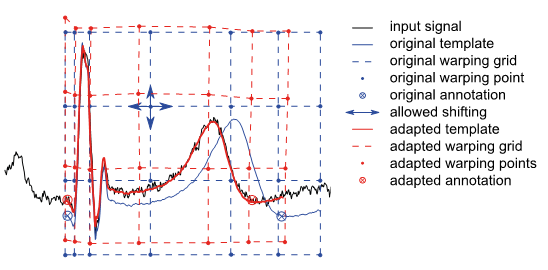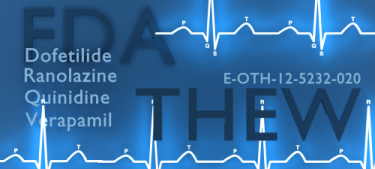
Harvard Medical School-Wyss Institute for Biologically Inspired Engineering, Boston, MA
|
University Medicine Berlin, Bonn, Germany
|
BioSign GmbH, Ottenhofen, Germany
|
University of Rochester, Computer and Electrical Engineering, Rochester, NY
|
Rochester Institute of Technology, Microsystem Engineering, Rochester, NY
|
Medtronic, Inc., Mounds View, MN
|
| Learn more about our members: here |
| |
| New THEW publications: |
Kocabas O, Soyata T, Couderc JP, Aktas M, Xia J, and Huang M., Assessment of Cloud - based Health Monitoring using Homomorphic Encryption. In: Computer Design (ICCD), 2013 IEEE 31st International Conference on DOI: 10.1109/ICCD.2013.6657078 Publication Year: 2013 , Page(s): 443 - 446 . PLoS One 2013;8(2):e57175.
|
A. Page, O. Kocabas, S. Ames, M. Venkitasubramaniyam, and T. Soyata, Cloud-based Secure Health Monitoring: Optimizing Fully-Homomorphic Encryption for Streaming Algorithms, IEEE Globecom 2014 Workshop on Cloud Computing Systems, Networks, and Applications (CCSNA), pp. , Dec 2014.
|
Sterling, Mark, David T. Huang, and Behnaz Ghoraani. "Developing a New Computer-aided Clinical Decision Support System For Prediction of Successful Post-cardioversion Patients With Persistent Atrial Fibrillation.".Engineering in Medicine and Biology Society (EMBC), 2014 36th Annual International Conference of the IEEE. (2015).
|
A Sadrieh, L Domanski, J Pitt-Francis, S A.Mann, E C. Hodkinson, Chai-Ann Ng, M D. Perry, JA.Taylor, David Gavaghan, R N.Subbiah, J I.Vandenberg, AP. Hill. Multiscale cardiac modelling reveals the origins of notched T waves in long QT syndrome type 2, Nature Communications 5, Article number: 5069 doi:10.1038/ncomms6069, nature communications
|
Y Zhu, X Yang, Z Wang, Y Peng. An Evaluating Method for Autonomic Nerve Activity by Means of Estimating the Consistency of Heart Rate Variability and QT Variability,Biomedical Engineering, IEEE Transactions on , vol.61, no.3, pp.938,945, March 2014.
|
R L. Lux, C Todd Sower, N Allen, S P. Etheridge, M Tristani-Firouzi, E V. Saarel. The application of root mean square electrocardiography (RMS ECG) for the detection of acquired and congenital long QT syndrome. PLoS One. 2014 Jan 15;9(1). PLoS One 2013;15(1).
|
Albert Feeny, Lichy Han, Larisa G. Tereshchenko, Repolarization lability measured on 10-second ECG by spatial TT′angle:reproducibility and agreement with QT variability. J Electrocardiol. 2014 Jun 9.
|
Y Zhu, X Yang, Z Wang, Y Peng. Comparative Analysis of Short-Term Vari ability of RR and QT Intervals for the Assessment of Autonomic Nerve Activity ISSN 2325-8861 Computing in Cardiology 2013; 40:73-76.
|
J Halamek, P Jurak, P Leinveber, V Vondra, JP Couderc. Comparing the Relationsh ip between QT/RR Slope and Basal QTc in LQT1 Patients and Healthy Subjects ISSN 2325-8861 Computing in Cardiology 2013; 40:65-68.
|
M Llamedo, JP Martínez, M Albertal, D Romero,E Pueyo, P Laguna. Morphologic Features of the ECG for Detection of Stress-Induced Ischemia ISSN 2325-886 Computing in Cardiology 2013; 40:591-594.
|
| Massimo W. Rivolta, Luca T. Mainardi, Roberto Sassi, Quantification of Ventricular Repolarization Heterogeneity during Moxifloxacin Administration using V-index Cardiovascular Oscillations (ESGCO), 2014 8th Conference of the European Study Group on, vol.,no.,pp.183,184,25-28 May 2014 |
www.thew-project.org |
 |
Keep updated about our initiative. Register to our LinkedIn group - 654 registered members. |
|


|
| NEW FDA DATA SHARING AGREEMENT and NEW ECG DATABASE ANNOUNCEMENT
EDITORIAL by JP Couderc |
This first issue of the THEW Newsletter for 2015 marks the start of the THEW initiative’s seventh year of operation. Over the past year, nine articles based on data from the THEW were published in peer-review journals, including Nature Communication, IEEE Transaction on Biomedical Engineering, and PLoS One. In addition, during 2014, the list of organizations registered with our initiative also grew nicely. We were delighted to welcome organizations such as Medtronic, BioSign, and the Harvard Medical School-Wyss Institute amongst others.
This February issue also announces that, through a data sharing agreement executed with the FDA, multiple ECG database will be released from multiple drug studies designed and conducted by scientists at the FDA. We are excited to release the first study from this set, the so-called FDA1 study, which was conducted by the Center for Drug Research and Evaluation (CDER) and Center for Devices and Radiological Health (CDRH). This study was a randomized controlled, five-way single-dose crossover clinical trial in 22 healthy subjects. It includes 5,232 ECGs. The drugs evaluated in this study included dofetilide, quinidine sulfate, ranolazine, and verapamil hydrochloride. The selection of the tested drugs was designed to facilitate the analysis of the effect of multichannel drug block on the repolarization interval; specifically the QT, the J-Tpeak (end of QRS to peak of T wave), and the Tpeak to Tend intervals. We would like to acknowledge the generous efforts of Drs. David Strauss, Lars Johannesen, and Jose Vicente who prepared and delivered this database to the THEW. A brief article below describes this new important ECG dataset, which is now available for download. A link to a more detailed description of the database is provided as well.
Also in this issue, Prof. Mathias Baumert from the University of Adelaide (Australia) presents a unique and very interesting technique developed for the measurement of beat-to-beat QT interval, and a quantification of its variability. Prof. Baumert and his collaborators started working with the THEW data in 2012, and recently released the so-called 2-D warping technique to measure instability of QT interval from surface ECGs. The technique is described in the Expert Opinion section of this issue. |
For more information about these data and technology please visit our website at http://thew-project.org. |
| Expert Opinion: Measuring beat-to-beat variability in ECG using two-dimensional signal warping. |
By Mathias Baumert, PhD |
The morphology of the ECG waveform varies slightly from beat to beat. Quantification of these changes, in particular within the ST-T segment, has been receiving increasing interest, because electrocardiographic phenomena such as microvolt T wave alternans and augmented QT interval variability have been associated with malignant ventricular arrhythmia in clinical populations as well pro-arrhythmic risk in pharmacological safety testing studies. More recently, P wave variability has received attention by cardiologists due its potential link to atrial fibrillation propensity. Since all those ECG changes are typically very small, high precision as well as robustness of measurement algorithm is of utmost importance for obtaining reliable results.
The morphology of ECG waveforms varies slightly from beat to beat. Quantification of these changes, in particular within the ST-T segment, has been receiving increasing interest, because electrocardiographic phenomena such as microvolt T wave alternans and augmented QT interval variability have been associated with malignant ventricular arrhythmia in clinical populations as well pro-arrhythmic risk in pharmacological safety testing studies. More recently, P wave variability has received attention by cardiologists due its potential link to atrial fibrillation propensity. Since all those ECG changes are typically very small, high precision as well as robustness of the measurement algorithm are of utmost importance for obtaining reliable results.
The technique proposed in [1] provides a general framework for analysing beat-to-beat changes in ECG and can be utilized for accurately tracking changes in common features of interest, e.g. the P, QRS or QT intervals or amplitude related information. The algorithm first generates a template beat based on ensemble averaging of relatively noise-free beats. Features of interest are annotated on the template in a semi-automated fashion. The template is then adapted to each incoming beat by exploiting a technique called two-dimensional signal warping. In brief, a 2D mesh of warping points is superimposed on the template beat. These warping points are sequentially shifted in x- and y-directions, minimizing the Euclidean distance between segments of the template and the incoming beat. From the optimally adapted template, changes in annotated features can be quantified, providing the foundation for beat-to-beat ECG variability analysis. The algorithm was proved to measure QT variability with high precision and is robust to common ECG artefacts [1, 2, 3]. |

Figure: Illustration of the two-dimensional signal warping algorithm. The template beat (blue) is mapped to a warping grid (blue), which is adapted to the incoming beat (black) by moving the warping points such that the distance between template and incoming beat is minimized. The optimally fitted template and corresponding warping points are shown in red.
References for this article can be found here. |
| FDA CORNER : NEW ECG Database |

|
We are pleased to announce a new ECG database available to the THEW members. This new database of standard 12-lead ECGs and corresponding pharmacokinetic data from the |
U.S. Food and Drug Administration (FDA) sponsored study, “A Double-Blind, Randomized, Placebo-Controlled Single-Dose, Five Period Crossover Study of the Electrocardiographic Effects of Ranolazine, Dofetilide, Verapamil and Quinidine in Healthy Subjects.” The FDA conducted this clinical trial to study the ability of novel electrocardiographic biomarkers to differentiate the effects of multichannel drug block. This is important because drugs that block inward ion channel currents (i.e. calcium and late sodium) in addition to the hERG potassium channel can have a lower risk of torsade de pointes than drugs that only block the hERG potassium channel. The primary results of the study were published in Johannesen et al. (Clinical Pharmacology & Therapeutics, 2014). FDA is releasing the data to the THEW to enable outside researchers to study additional algorithms, biomarkers and hypotheses.
In summary, the study was a randomized controlled five-way single-dose crossover clinical trial in 22 healthy volunteers (11 females) at a phase I clinical research unit (Spaulding Clinical, West Bend, WI). The drugs evaluated in this study were dofetilide (500microg, Tikosyn, Pfizer, New York, NY), quinidine sulfate (400mg, Watson Pharma, Corona, CA), ranolazine (1,500mg, Ranexa, Gilead, Foster City, CA), and verapamil hydrochloride (120mg, Heritage Pharmaceuticals, Edison, NJ). In the morning of each treatment period, the subjects received one of the four drugs or placebo under fasting conditions. There was a 7-day washout period between each 24-h treatment period. Prior to dosing, a continuous 12-lead ECG recorder (Surveyor, Mortara Instrument, Milwaukee, WI) using the MasonLikar electrode configuration was connected to each subject. From the continuous recording, three replicate 10sec ECGs (pre- and postdose) were extracted at 16 predefined time-points (predose and 0.5, 1, 1.5, 2, 2.5, 3, 3.5, 4, 5, 6, 7, 8, 12, 14, 24h postdose), during which the subjects were resting in a supine position for 10 min. This resulted in a total of 48 ECGs per subject per treatment period and 5,280 in total. After each ECG extraction time-point period, a blood sample was drawn for pharmacokinetic analysis. Plasma drug concentration was determined using a validated liquid chromatography with tandem mass spectroscopy method by Frontage Laboratories (Exton, Philadelphia, PA).
More information about the database can be found here. |
| THEW Team Member |

John DeCamilla
John DeCamilla has recently joined the THEW team. Mr. DeCamilla has had considerable experience |
in clinical services and clinical research programs at the University of Rochester in the past, and was a successful entrepreneur & principal investigator for a number of federally sponsored research activities within his own medical R&D firm.
He has over 35 years of operations, management, and technical experience in the non-profit and for-profit sectors; has over 50 professional publications; and has received numerous professional and community service awards. John credits his diverse career & professional successes to the mentoring and guidance he received from Dr. Arthur Moss at the University of Rochester Medical Center: “Dr. A.J. Moss created a professional and personal environment that encouraged my growth and creativity." |
|
